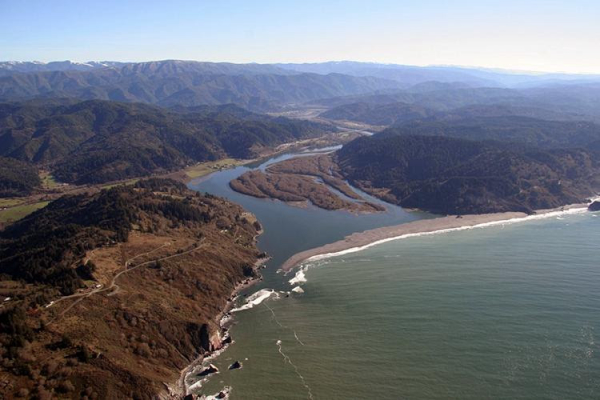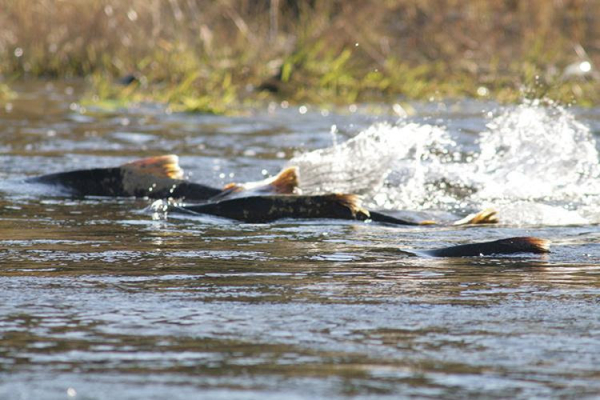 Mouth of the Klamath River. (Photo: Thomas Dunklin)
Mouth of the Klamath River. (Photo: Thomas Dunklin)Once underway, the anticipated removal of four dams along the Klamath River would result in the largest such dam removal effort ever undertaken. But when reopening rivers for migratory fish, removing barriers like dams and culverts is just the beginning. There also needs to be plenty of high-quality habitat for fish to access upstream. For the past two decades, fish passage experts, landowners, and community members have worked to build a network of restored habitat. This habitat will support salmon, steelhead, and other species throughout the Klamath River watershed.
The Klamath River flows through southern Oregon and northern California. It provides habitat for dozens of native fish species, including threatened coho salmon, Chinook salmon, and steelhead trout, as well as multiple species of lamprey and suckers. The river’s fisheries provide important subsistence and cultural resources for tribal communities. They also support the region’s recreational and commercial fishing industries.
The Klamath was once the third largest salmon-producing river on the West Coast. But several dams, combined with land and water use impacts, have contributed to declines in salmon and steelhead abundance. Fish are blocked from accessing their habitat in much of the watershed. The decline in fish populations has impacted tribal, recreational, and commercial fisheries and the communities and economies they support.

Partners from across the region have collaborated for years on a plan to reopen more than 400 miles of habitat by removing four dams on the lower Klamath River. As that plan has moved forward, efforts to improve fish passage and restore habitat elsewhere in the watershed have also progressed. When the anticipated future dam removals occur, they will allow fish to access many miles of habitat strategically restored by NOAA and partners.
Tribes, nonprofit organizations, private landowners, and federal, state, and local government agencies have worked together across the Klamath River region over the past 20 years. They have implemented more than 124 restoration projects to improve habitat for salmon. Many of these efforts are highlighted in a new story map created by the California Fish Passage Forum, Klamath River Renewal Corporation, and other partners. Among the projects are several supported by NOAA Fisheries funding and technical assistance, including:
- Fort Goff Bridge Project: This project removed a 15-foot diameter culvert that was preventing salmon and steelhead from migrating up Fort Goff Creek. The culvert, located at a road crossing, was replaced with a 60-foot span bridge. The first winter after construction was completed, 64 Chinook salmon nests (redds) were observed upstream of the new bridge.
- Grenada Irrigation District Dam Removal: This project removed a 12-foot tall dam along the Shasta River, one of the most important spawning tributaries in the Klamath River watershed. Removal of the dam opened up year-round access to 23 miles of coldwater habitat for salmon and steelhead. Monitoring efforts have detected juvenile fish passing through the former dam site on their way upstream.
- Sharber-Peckham Fish Passage Project: This project replaced an undersized culvert that was blocking fish migration along Sharber-Peckham Creek. Replacement of the culvert reopened access to more than 1 mile of spawning and rearing habitat for coho and Chinook salmon and steelhead trout. In 2017, monitoring conducted by the U.S. Forest Service identified 740 juvenile coho rearing upstream of the project site.
- Whites Gulch Dam Removal: This project removed two dams in the Salmon River, a tributary to the Klamath River located in Northern California. Removal of the two barriers reopened approximately one mile of high-quality spawning and rearing habitat for Chinook salmon, coho salmon, and steelhead.

NOAA supported these and other projects in the Klamath River region through funding sources such as the Community-based Restoration Program and the Pacific Coastal Salmon Recovery Fund. Our staff also provided technical expertise needed to move projects forward by helping coordinate funding strategies, developing project monitoring plans, and more.
Individually, each of the many projects in this region is providing important fish passage and water quality benefits. Together, these collective efforts are helping to reconnect a network of habitat for the salmon, steelhead, and other species that depend on the Klamath River and its tributaries.


 Advertising
Advertising